Breaking down barriers: How to support students with learning disabilities
Introduction
Supporting students with learning disabilities is critical to ensuring their academic success and overall well-being. Learning disabilities can present unique challenges for students, affecting their ability to acquire and process information in traditional ways. The purpose of this blog post is to provide a comprehensive understanding of learning disabilities, including their definition and how they can affect students. These include the importance of early identification and intervention, strategies for creating an inclusive classroom environment, the benefits of individualized education plans (IEPs), the role of assistive technology, building a support network, addressing prejudice and stereotypes, and self-advocacy. Will also explore the importance of promoting and empowering, and celebrating the achievements of students with learning disabilities.
Understanding learning disabilities: What are they and how do they affect students?
Learning disabilities are neurological processing disorders that can affect how individuals acquire, process, store, and respond to information. These disabilities can manifest in a variety of ways, affecting a student’s ability to read, write, spell, solve math problems, or understand and express language. It is important to note that learning disabilities do not indicate a lack of intelligence or effort. Rather, they are specific challenges that require targeted support.
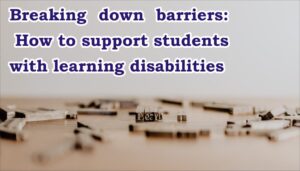
The impact of a learning disability can vary from student to student. For example, a student with dyslexia may struggle with reading and writing, while a student with dyscalculia may have difficulty with math concepts. Other common learning disabilities include dysgraphia (difficulty writing), auditory processing disorder (difficulty processing auditory information), and attention-deficit/hyperactivity disorder (ADHD), which affects attention span and impulse control. can affect It is important for educators and parents to understand the specific challenges faced by students with learning disabilities in order to provide appropriate support.
Identifying students with learning disabilities: Signs and symptoms to look for
Early identification of learning disabilities is essential to provide timely intervention and support. There are several signs and symptoms that educators and parents can watch for. These may include difficulties with reading, writing, spelling, or math. struggle with following instructions or staying focused; problems with organization and time management; and challenges with social interactions or emotional regulation.
It is important to note that these signs and symptoms may not always indicate a learning disability, as each student is unique and may have different strengths and weaknesses. However, if a student consistently exhibits several of these signs and symptoms, it may be worth exploring the possibility of a learning disability and seeking further evaluation.
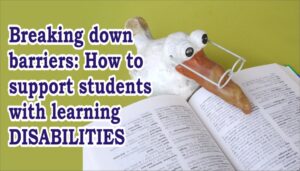
The importance of early intervention: Helping students with learning disabilities from the beginning
Early intervention is critical to helping students with learning disabilities and setting them up for success. Research shows that early identification and intervention can significantly improve outcomes for students with learning disabilities. By providing targeted support and accommodations early on, teachers can help students overcome challenges and develop strategies to meet their specific learning needs.
Strategies to support students with learning disabilities in the early years include implementing multisensory teaching methods, breaking tasks into small steps, providing visual aids and cues, providing repeated opportunities for practice and reinforcement and May include fostering a positive and supportive learning environment. It is also important to involve parents in this process, as they play an important role in supporting their child’s learning and meeting their needs.
Creating an Inclusive Classroom: Strategies for Breaking Down Barriers and Supporting All Students
Creating an inclusive classroom environment is essential to support students with learning disabilities and promote their overall well-being. Inclusion means ensuring that all students, regardless of their abilities or disabilities, feel valued, respected, and supported in the classroom. This includes breaking down barriers and giving all students equal opportunities to participate and succeed.
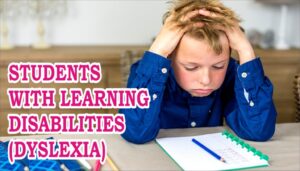
Strategies for creating an inclusive classroom include differentiating instruction to meet the diverse needs of students, providing a variety of learning materials and resources, fostering a sense of belonging and acceptance, and fostering cooperation and peer support. , and may include implementing Universal Design for Learning (UDL). By embracing diversity and creating an inclusive classroom, educators can help students with learning disabilities thrive academically and socially.
Individualized Education Plans (IEPs): How they can help students with learning disabilities succeed
Individualized Education Plans (IEPs) are personalized plans developed for students with learning disabilities to ensure they receive the supports and accommodations they need to succeed in school. An IEP is a legally binding document that outlines a student’s specific learning needs, goals, and the strategies and accommodations that will be implemented to support their learning.
IEPs are developed through a collaborative process involving parents, teachers, and other professionals, such as special education teachers or speech therapists. The process begins with an assessment to determine the student’s strengths and areas of need. Based on the assessment results, specific goals are set, and strategies and accommodations are identified to support student learning. Regular meetings are held to review progress and make any necessary adjustments to the plan.
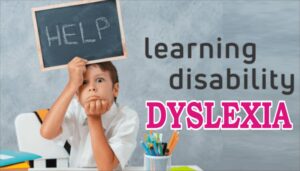
Assistive Technology: Tools and Resources to Support Students with Learning Disabilities
Assistive technology refers to tools, equipment, or software that can help people with learning disabilities overcome challenges and access information easily. These technologies can provide support in a variety of areas, such as reading, writing, organization, math, and communication.
Examples of assistive technology tools and resources include text-to-speech software, speech recognition software, graphic organizers, calculators with large displays or audio feedback, and electronic note-taking devices. These tools can help students with learning disabilities become more independent learners and access the curriculum on an equal basis with their peers.
Building a Support Network: Collaborating with parents, teachers, and professionals to support student growth
Building a strong support network is essential for students with learning disabilities to thrive. Collaboration between parents, teachers, and professionals is key to ensuring that students receive the necessary support and accommodations both at home and in the classroom.
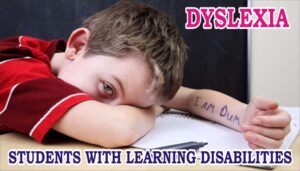
Regular communication and collaboration between parents and teachers can help ensure that student needs are being met and that strategies and accommodations are consistent across environments. Specialists, such as speech therapists or occupational therapists, can provide additional support and expertise to address specific areas of need. By working together as a team, parents, teachers, and professionals can create a supportive and inclusive learning environment for students with learning disabilities.
Overcoming stigma and stereotypes: promoting understanding and acceptance of learning disabilities
Learning disabilities are often misunderstood, leading to stigma and stereotypes. Addressing these misconceptions and promoting understanding and acceptance of learning disabilities is essential to creating an inclusive and supportive environment for students.
One way to promote understanding is through education and awareness. Educators can provide information about learning disabilities to students, parents, and the wider community, which can help dispel myths and misconceptions. It is also important to foster a culture of empathy and acceptance in the classroom, where differences are celebrated and all students are valued for their unique strengths.
Self-advocacy and empowerment: Helping students with learning disabilities build confidence and independence
Self-advocacy and empowerment are critical to helping students with learning disabilities build confidence and independence. By teaching students to understand their own strengths and challenges, advocate for their needs, and develop strategies to overcome obstacles, teachers help them become active participants in their own learning journeys. can.
Self-advocacy and empowerment strategies include educating students about their specific learning disabilities, helping them identify their strengths and areas of need, providing opportunities for self-reflection and goal setting, self May include teaching regulation strategies, and fostering a growth mindset. . By empowering students with learning disabilities, educators can help them develop the skills and mindsets necessary for academic and life success.
Celebrating success: Recognizing and celebrating the achievements of students with learning disabilities
Recognizing and celebrating the achievements of students with learning disabilities is essential to fostering a positive mindset and building self-esteem. It is important to recognize the progress and effort that students with learning disabilities put into their learning, regardless of the results.
Strategies for celebrating success include providing specific and meaningful feedback, highlighting individual strengths and achievements, showcasing student work or projects, and involving students in setting their own goals and tracking their progress. Can be included. By celebrating success, educators can help students with learning disabilities develop positive attitudes toward learning and resilience in the face of challenges.
Result
Supporting students with learning disabilities is critical to ensuring their academic success and overall well-being. By understanding learning disabilities, identifying affected students, providing early intervention, creating an inclusive classroom environment, developing individualized education plans, using assistive technology, building a support network, and by dispelling stereotypes, promoting self-advocacy and empowerment, and celebrating. Success, educators can help students with learning disabilities develop and reach their full potential. It’s important to remember that every student is unique and may need different strategies and accommodations, so it’s important to provide support to meet their specific needs. By working together as a team, teachers, parents, and professionals can create a supportive and inclusive learning environment where all students can succeed.

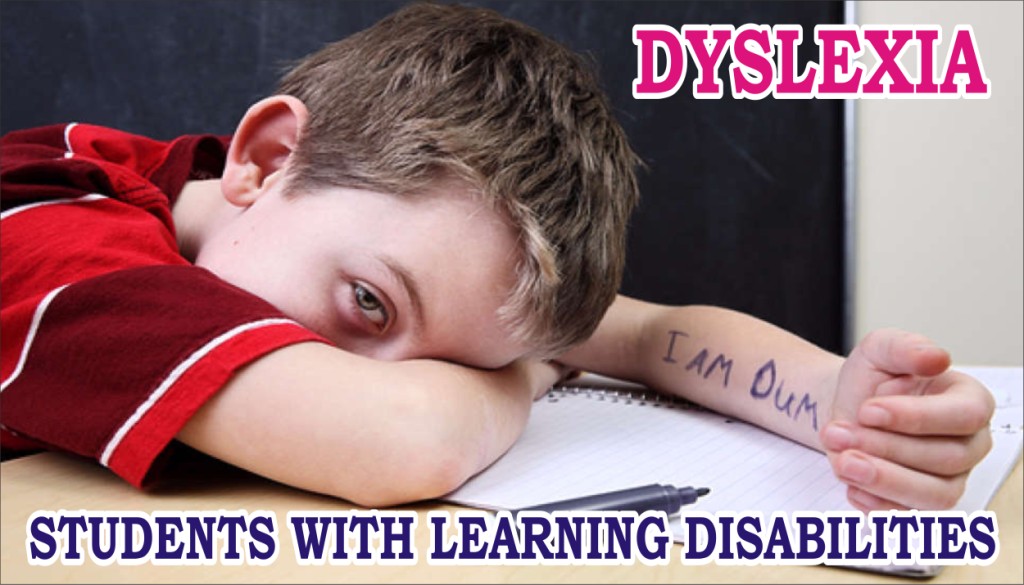
Students should be guided aways.
I really love the theme/design of your website. Do you ever run into any browser compatibility problems? A small number of my blog audience have complained about my site not working correctly in Explorer but looks great in Safari. Do you have any ideas to help fix this problem?
Greetings!
Change your theme. or contact my team at tasos.mirza@gmail.com to visit your website.